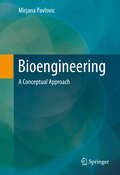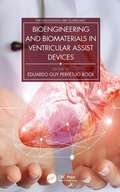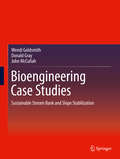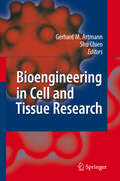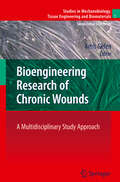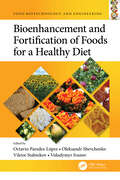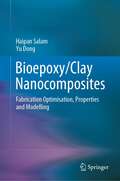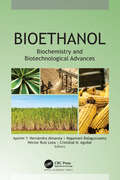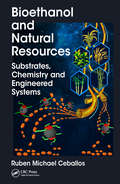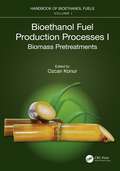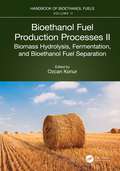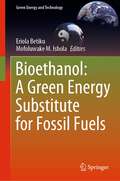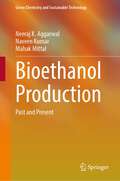- Table View
- List View
The Bioengineered Forest: Challenges for Science and Society
by Steven H. StraussBioengineering offers many opportunities for forestry. Bioengineered trees can produce more valuable wood, help reclaim contaminated land, improve the health of urban trees, and facilitate pest management. But the ecological risks are complex, and public views about the ethical acceptability of genetic engineering vary widely. Unique in its breadth and diversity, The Bioengineered Forest begins with a survey of the range of forestry practices for which the use of biotechnologies might be appropriate. Scholars representing diverse academic perspectives and viewpoints examine in depth the economic and environmental rationale for forest biotechnologies and the current state of technology with respect to gene performance and safety. They consider the contemporary political and economic environment in which bioengineering is being introduced and where the 'genomic revolution' might take forestry and genetic engineering in the future. The Bioengineered Forest presents compelling arguments in favor of genetic engineering. Just as powerfully, it examines the significant technical and legal hurdles involved in genetic engineering, the undesirable environmental and social consequences that might result from its misapplication, and the risks for businesses that are looking too exclusively for near-term benefits.
The Bioengineered Forest: Challenges for Science and Society
by Steven H. StraussBioengineering offers many opportunities for forestry. Bioengineered trees can produce more valuable wood, help reclaim contaminated land, improve the health of urban trees, and facilitate pest management. But the ecological risks are complex, and public views about the ethical acceptability of genetic engineering vary widely. Unique in its breadth and diversity, The Bioengineered Forest begins with a survey of the range of forestry practices for which the use of biotechnologies might be appropriate. Scholars representing diverse academic perspectives and viewpoints examine in depth the economic and environmental rationale for forest biotechnologies and the current state of technology with respect to gene performance and safety. They consider the contemporary political and economic environment in which bioengineering is being introduced and where the 'genomic revolution' might take forestry and genetic engineering in the future. The Bioengineered Forest presents compelling arguments in favor of genetic engineering. Just as powerfully, it examines the significant technical and legal hurdles involved in genetic engineering, the undesirable environmental and social consequences that might result from its misapplication, and the risks for businesses that are looking too exclusively for near-term benefits.
Bioengineering: A Conceptual Approach (SpringerBriefs in Computer Science #0)
by Mirjana PavlovicThis book explores critical principles and new concepts in bioengineering, integrating the biological, physical and chemical laws and principles that provide a foundation for the field. Both biological and engineering perspectives are included, with key topics such as the physical-chemical properties of cells, tissues and organs; principles of molecules; composition and interplay in physiological scenarios; and the complex physiological functions of heart, neuronal cells, muscle cells and tissues. Chapters evaluate the emerging fields of nanotechnology, drug delivery concepts, biomaterials, and regenerative therapy. The leading individuals and events are introduced along with their critical research. Bioengineering: A Conceptual Approach is a valuable resource for professionals or researchers interested in understanding the central elements of bioengineering. Advanced-level students in biomedical engineering and computer science will also find this book valuable as a secondary textbook or reference.
Bioengineering and Biomaterials in Ventricular Assist Devices (Emerging Materials and Technologies)
by Eduardo Guy Perpétuo BockOften associated with artificial hearts, ventricular assist devices (VADs) are blood pumps that can provide circulatory assistance to the left ventricle, the right ventricle, or both. Bioengineering and Biomaterials in Ventricular Assist Devices reviews constructive details of VADs and the biomaterials used in their development and support. FEATURES Establishes an area of intersection between engineering and medicine Shows process development from mechanical design to automation and control Discusses biofunctional materials, tribology in ceramic biomaterials, biosensors, and surface engineering and blood This text is aimed at advanced students, researchers, and practicing engineers conducting work on VADs and will be of interest to a broad interdisciplinary group, including bioengineers, materials engineers, chemical engineers, mechanical engineers, and electrical engineers.
Bioengineering and Biomaterials in Ventricular Assist Devices (Emerging Materials and Technologies)
by Eduardo Guy Perpétuo BockOften associated with artificial hearts, ventricular assist devices (VADs) are blood pumps that can provide circulatory assistance to the left ventricle, the right ventricle, or both. Bioengineering and Biomaterials in Ventricular Assist Devices reviews constructive details of VADs and the biomaterials used in their development and support. FEATURES Establishes an area of intersection between engineering and medicine Shows process development from mechanical design to automation and control Discusses biofunctional materials, tribology in ceramic biomaterials, biosensors, and surface engineering and blood This text is aimed at advanced students, researchers, and practicing engineers conducting work on VADs and will be of interest to a broad interdisciplinary group, including bioengineers, materials engineers, chemical engineers, mechanical engineers, and electrical engineers.
Bioengineering and Biophysical Aspects of Electromagnetic Fields, Fourth Edition (Handbook of Biological Effects of Electromagnetic Fields)
by Ben Greenebaum Frank BarnesThe two volumes of this new edition of the Handbook cover the basic biological, medical, physical, and electrical engineering principles. They also include experimental results concerning how electric and magnetic fields affect biological systems—both as potential hazards to health and potential tools for medical treatment and scientific research. They also include material on the relationship between the science and the regulatory processes concerning human exposure to the fields. Like its predecessors, this edition is intended to be useful as a reference book but also for introducing the reader to bioelectromagnetics or some of its aspects. FEATURES • New topics include coverage of electromagnetic effects in the terahertz region, effects on plants, and explicitly applying feedback concepts to the analysis of biological electromagnetic effects • Expanded coverage of electromagnetic brain stimulation, characterization and modeling of epithelial wounds, and recent lab experiments on at all frequencies • Section on background for setting standards and precautionary principle • Discussion of recent epidemiological, laboratory, and theoretical results; including: WHO IARC syntheses of epidemiological results on both high and low frequency fields, IITRI lab study of cancer in mice exposed to cell phone-like radiation, and other RF studies • All chapters updated by internationally acknowledged experts in the field
Bioengineering and Biophysical Aspects of Electromagnetic Fields, Fourth Edition (Handbook of Biological Effects of Electromagnetic Fields)
by Ben Greenebaum Frank BarnesThe two volumes of this new edition of the Handbook cover the basic biological, medical, physical, and electrical engineering principles. They also include experimental results concerning how electric and magnetic fields affect biological systems—both as potential hazards to health and potential tools for medical treatment and scientific research. They also include material on the relationship between the science and the regulatory processes concerning human exposure to the fields. Like its predecessors, this edition is intended to be useful as a reference book but also for introducing the reader to bioelectromagnetics or some of its aspects. FEATURES • New topics include coverage of electromagnetic effects in the terahertz region, effects on plants, and explicitly applying feedback concepts to the analysis of biological electromagnetic effects • Expanded coverage of electromagnetic brain stimulation, characterization and modeling of epithelial wounds, and recent lab experiments on at all frequencies • Section on background for setting standards and precautionary principle • Discussion of recent epidemiological, laboratory, and theoretical results; including: WHO IARC syntheses of epidemiological results on both high and low frequency fields, IITRI lab study of cancer in mice exposed to cell phone-like radiation, and other RF studies • All chapters updated by internationally acknowledged experts in the field
Bioengineering Applications of Carbon Nanostructures (Nanomedicine and Nanotoxicology)
by Ado JorioThis book covers the development of biotechnology based on carbon nanostructures, with a focus on nanotubes, addressing also fullerenes and amorphous carbons. The book is divided into 7 chapters, addressing tissue engineering, genetic engineering and therapy, as well as the environmental and health impacts of carbon nanostructures.
Bioengineering Approaches to Pulmonary Physiology and Medicine
by Michael C. K. KhooAs the current millennium steams towards a close, one cannot help but look with amazement at the incredible amount of progress that has been achieved in medicine in just the last few decades. A key contributing factor to this success has been the importation and blending of ideas and techniques from disciplines outside the traditional borders of medical science. In recent years, the most well-known example is the cross-pollination between molecular biology and medicine. Advances driven by this potent combination have spawned the vision of a future where cures based on gene therapy become commonplace. Yet, as we continue our search for "magic bullets" in the quest to eradicate disease, it important to recognize the value of other less-heralded interdisciplinary efforts that have laid a large part of the foundation of present-day medicine. In pulmonary medicine, the contribution from the bioengineers (a diverse collection of individuals cross-bred to various degrees in mathematical modeling and experimental physiology) has been larger and more sustained than in many other medical specialties. It is easy to point to the vast array of ventilators, blood-gas analyzers, oximeters, pulmonary function devices, and respiration monitors that are present in any modern clinical setting as solid evidence of the successful synergy between engineering science and pulmonary medicine. However, one must not forget the less tangible, but perhaps more important, contributions that have been derived from mathematical modeling and computer simulation, without which many of these modern instruments would not have come into existence.
Bioengineering Case Studies: Sustainable Stream Bank and Slope Stabilization
by Wendi Goldsmith Donald Gray John McCullah"Bio-Stabilization Case Studies: Treatment and Performance Evaluation" describes and evaluates 30 projects from across the United States where bio-stabilization was employed to address a detrimental naturally occurring process or byproduct of the built environment. Bio-stabilization (or soil bioengineering) refers to the use of plant materials, primarily live cuttings, arranged in the ground in different arrays to reinforce soils and protect upland slopes and/or stream banks against surficial erosion and shallow slope failures. Examples included in the collection represent different regions of the country and their specific conditions and challenges. Each project is illustrated with a number of distinctive photographs to support the reader's understanding and showcase the wide scope of projects and techniques presented. The volume is ideal for civil and environmental engineers and environmental scientists working on watershed, infrastructure projects, and municipal scale installations.
Bioengineering in Cell and Tissue Research
by Gerhard M. Artmann Shu ChienCutting edge research in cell and tissue research abounds in this review of the latest technological developments in the area. The chapters are written by excellent scientists on advanced, frontier technology and address scientific questions that require considerable engineering brainpower. The aim is to provide students and scientists working in academia and industry new information on bioengineering in cell and tissue research to enhance their understanding and innovation.
Bioengineering Research of Chronic Wounds: A Multidisciplinary Study Approach (Studies in Mechanobiology, Tissue Engineering and Biomaterials #1)
by Amit GefenPressure-related chronic wounds are an important health concern that affects millions of patients and accumulates billions in annual costs. These wounds may occur when soft tissues are mechanically compressed between bony prominences and a supporting surface. This book gives a complete and quantitative explanation of the mechanobiology which causes chronic wounds. The reviews give an overall picture on all length scales of the phenomenon, starting from musculoskeletal biomechanics to the modeling of soft tissues and their interaction with bones. At the microscopic levels, it thoroughly reviews experiments and modeling of cellular forces and molecular processes that occur during injury and healing, including the integrity of living cells subjected to sustained mechanical forces and deformations. The results allow a complete picture of the tolerance of human tissues to sustained loads, and an understanding of the risk for onset of chronic wounds. Hence, this book is also valuable for all professionals involved in the prevention and treatment of chronic wounds.
Bioenhancement and Fortification of Foods for a Healthy Diet (Food Biotechnology and Engineering)
by Octavio Paredes-López Oleksandr Shevchenko Viktor Stabnikov Volodymyr IvanovBioenhancements of cereal and dairy compositions can play an important role in healthy diets. The latest addition to the new Food Biotechnology and Engineering series, Bioenhancement and Fortification of Foods for a Healthy Diet covers the technological and nutritional aspects of the compositions of cereals, dairy products, vegetables, and fruits. The book demonstrates real developments in food technology and reviews current knowledge in the biotechnological processing and bioenhancement of food. Key Features: Promotes the use of iron-containing nanoadditive in bakery and confectionary Explains the use of food additives for enrichment of butter mixtures Covers the use of artichoke powder and buckwheat bran in diabetic bakery products Describes the use of milk proteins in the technology of bakery products Proposes the use of spice compositions for sour milk products Organized in five parts, Bioenhancement and Fortification of Foods for a Healthy Diet addresses bakery and confectionery products, technologies for cereals enhancement, technologies for dairy products enhancement, food supplements, and finally, new technology processes. The book is an aide to food scientists and engineers contributing to the development of high-quality food products. Also available in the Food Biotechnology and Engineering series: Volatile Compounds Formation in Specialty Beverages, edited by Felipe Richter Reis and Caroline Mongruel Eleutério dos Santos (ISBN: 9780367631901) Native Crops in Latin America: Biochemical, Processing, and Nutraceutical Aspects, edited by Ritva Repo-Carrasco-Valencia and Mabel C. Tomás (ISBN: 9780367531409) For a complete list of books in this series, please visit our website at: https://www.routledge.com/Food-Biotechnology-and-Engineering/book-series/CRCFOOBIOENG
Bioenhancement and Fortification of Foods for a Healthy Diet (Food Biotechnology and Engineering)
by Octavio Paredes-López Oleksandr Shevchenko Viktor Stabnikov Volodymyr IvanovBioenhancements of cereal and dairy compositions can play an important role in healthy diets. The latest addition to the new Food Biotechnology and Engineering series, Bioenhancement and Fortification of Foods for a Healthy Diet covers the technological and nutritional aspects of the compositions of cereals, dairy products, vegetables, and fruits. The book demonstrates real developments in food technology and reviews current knowledge in the biotechnological processing and bioenhancement of food. Key Features: Promotes the use of iron-containing nanoadditive in bakery and confectionary Explains the use of food additives for enrichment of butter mixtures Covers the use of artichoke powder and buckwheat bran in diabetic bakery products Describes the use of milk proteins in the technology of bakery products Proposes the use of spice compositions for sour milk products Organized in five parts, Bioenhancement and Fortification of Foods for a Healthy Diet addresses bakery and confectionery products, technologies for cereals enhancement, technologies for dairy products enhancement, food supplements, and finally, new technology processes. The book is an aide to food scientists and engineers contributing to the development of high-quality food products. Also available in the Food Biotechnology and Engineering series: Volatile Compounds Formation in Specialty Beverages, edited by Felipe Richter Reis and Caroline Mongruel Eleutério dos Santos (ISBN: 9780367631901) Native Crops in Latin America: Biochemical, Processing, and Nutraceutical Aspects, edited by Ritva Repo-Carrasco-Valencia and Mabel C. Tomás (ISBN: 9780367531409) For a complete list of books in this series, please visit our website at: https://www.routledge.com/Food-Biotechnology-and-Engineering/book-series/CRCFOOBIOENG
Bioepoxy/Clay Nanocomposites: Fabrication Optimisation, Properties and Modelling
by Haipan Salam Yu DongThis book highlights current advanced developments in bioepoxy and bioepoxy/clay nanocomposites and an optimisation of material formulation and processing parameters on fabrication of bioepoxy/clay nanocomposites in order to achieve the highest mechanical properties in relation to their morphological structures, thermal properties, as well as biodegradability and water absorption, which is based on the use of Taguchi design of experiments with the consideration of technical and economical point of view. It also elaborates holistic theoretical modelling of tensile properties of such bionanocomposites with respect to the effect of contents of nanoclay fillers and epoxydised soybean oil (ESO).
Bioethanol: Biochemistry and Biotechnological Advances
by Ayerim Y. Hernández AlmanzaThis new book, Bioethanol: Biochemistry and Biotechnological Advances, presents some insightful perspectives and important advances in the bioethanol industry. The volume goes into detail on the biochemical and physiological parameters carried out by the main bioethanol-producing microorganisms as well as the discusses the potential applications that bioproducts can have and the advantages they generate. The chapter authors discuss a variety of issues, including the physiology of ethanol production by yeasts, by Zymomonas mobilis, and by Clostridium thermocellum. Other sources of biofuel, such as sweet sorghum, Agave americana L. leaves waste, and fungi are included as well. Chapters also discuss the genetic regulation and genetic engineering of principal microorganisms and then go on to address ways to increase ethanol tolerance in industrially important ethanol fermenting organisms, methods for developing sustainable fermentable substrates, and new strategies for ethanol purification. Chapters explore the design and engineering requirements for bioreactors, bioelectrosynthesis of ethanol via bioelectrochemical systems, and more. The book will be a valuable resource for faculty and students in this area as well as for scientists, researchers, and managers in the biofuel industry in the area of biofuel production, fermentation process, environmental engineering and all other related scientific areas.
Bioethanol: Biochemistry and Biotechnological Advances
by Ayerim Y. Hernández Almanza Nagamani Balagurusamy Héctor Ruiz Leza Cristóbal N. AguilarThis new book, Bioethanol: Biochemistry and Biotechnological Advances, presents some insightful perspectives and important advances in the bioethanol industry. The volume goes into detail on the biochemical and physiological parameters carried out by the main bioethanol-producing microorganisms as well as the discusses the potential applications that bioproducts can have and the advantages they generate. The chapter authors discuss a variety of issues, including the physiology of ethanol production by yeasts, by Zymomonas mobilis, and by Clostridium thermocellum. Other sources of biofuel, such as sweet sorghum, Agave americana L. leaves waste, and fungi are included as well. Chapters also discuss the genetic regulation and genetic engineering of principal microorganisms and then go on to address ways to increase ethanol tolerance in industrially important ethanol fermenting organisms, methods for developing sustainable fermentable substrates, and new strategies for ethanol purification. Chapters explore the design and engineering requirements for bioreactors, bioelectrosynthesis of ethanol via bioelectrochemical systems, and more. The book will be a valuable resource for faculty and students in this area as well as for scientists, researchers, and managers in the biofuel industry in the area of biofuel production, fermentation process, environmental engineering and all other related scientific areas.
Bioethanol and Natural Resources: Substrates, Chemistry and Engineered Systems
by Ruben Michael CeballosBioethanol and Natural Resources: Substrates, Chemistry and Engineered Systems provides a comprehensive review of feedstocks, physiochemical and biological pretreatments, molecular substrates, cellulolytic and ligninolytic enzymes, and advanced technologies for producing bioethanol. Although this book provides a review of first-generation bioethanol feedstocks, chemistry, and processes, there is an emphasis on second-generation "cellulosic" ethanol production. With rapid advances in biofuels technologies and the continued global dependency on unsustainable extraction of fossil fuels, this text is timely. Although it is intended to be used as a supplemental text for advanced undergraduate or graduate level courses, the book is accessible to a non-academic audience. This book provides a unique opportunity to understand bioethanol production from the basic concepts and processes to the most cutting-edge technologies under development.
Bioethanol and Natural Resources: Substrates, Chemistry and Engineered Systems
by Ruben Michael CeballosBioethanol and Natural Resources: Substrates, Chemistry and Engineered Systems provides a comprehensive review of feedstocks, physiochemical and biological pretreatments, molecular substrates, cellulolytic and ligninolytic enzymes, and advanced technologies for producing bioethanol. Although this book provides a review of first-generation bioethanol feedstocks, chemistry, and processes, there is an emphasis on second-generation "cellulosic" ethanol production. With rapid advances in biofuels technologies and the continued global dependency on unsustainable extraction of fossil fuels, this text is timely. Although it is intended to be used as a supplemental text for advanced undergraduate or graduate level courses, the book is accessible to a non-academic audience. This book provides a unique opportunity to understand bioethanol production from the basic concepts and processes to the most cutting-edge technologies under development.
Bioethanol Fuel Production Processes. I: Biomass Pretreatments
by Ozcan KonurThis book presents research on biomass pretreatments, which are a fundamental part of bioethanol fuel production to make biomass more accessible. This book also includes an introductory section on the bioethanol fuels. Bioethanol Fuel Production Processes. I: Biomass Pretreatments is the first volume in the Handbook of Bioethanol Fuels (Six-Volume Set). The primary pretreatments at the macro level are the biological chemical, hydrothermal, and mechanical pretreatments of the biomass. It also has an introductory section on the biomass pretreatments at large for bioethanol fuel production. The major pretreatments at the micro level are the enzymatic and fungal pretreatments of the biomass as the biological pretreatments, acid, alkaline, ionic liquid, and organic solvent pretreatment pretreatments of the biomass as the chemical pretreatments, steam explosion and liquid hot water pretreatments of the biomass as the hydrothermal pretreatments, and milling, ultrasonic, and microwave pretreatments of the biomass as the mechanical pretreatments. The first volume also indicates that a wide range of pretreatments stand alone or in combination with each other fractionate the biomass to its constituents of cellulose, lignin, and hemicellulose and improve both sugar and bioethanol fuel yield, making this bioethanol fuel more competitive in relation to crude oil- and natural gas-based fossil fuels. This first volume is a valuable resource for the stakeholders primarily in the research fields of energy and fuels, chemical engineering, environmental science and engineering, biotechnology, microbiology, chemistry, physics, mechanical engineering, agricultural sciences, food science and engineering, materials science, biochemistry, genetics, molecular biology, plant sciences, water resources, economics, business, management, transportation science and technology, ecology, public, environmental and occupational health, social sciences, toxicology, multidisciplinary sciences, and humanities among others.
Bioethanol Fuel Production Processes. I: Biomass Pretreatments
This book presents research on biomass pretreatments, which are a fundamental part of bioethanol fuel production to make biomass more accessible. This book also includes an introductory section on the bioethanol fuels. Bioethanol Fuel Production Processes. I: Biomass Pretreatments is the first volume in the Handbook of Bioethanol Fuels (Six-Volume Set). The primary pretreatments at the macro level are the biological chemical, hydrothermal, and mechanical pretreatments of the biomass. It also has an introductory section on the biomass pretreatments at large for bioethanol fuel production. The major pretreatments at the micro level are the enzymatic and fungal pretreatments of the biomass as the biological pretreatments, acid, alkaline, ionic liquid, and organic solvent pretreatment pretreatments of the biomass as the chemical pretreatments, steam explosion and liquid hot water pretreatments of the biomass as the hydrothermal pretreatments, and milling, ultrasonic, and microwave pretreatments of the biomass as the mechanical pretreatments. The first volume also indicates that a wide range of pretreatments stand alone or in combination with each other fractionate the biomass to its constituents of cellulose, lignin, and hemicellulose and improve both sugar and bioethanol fuel yield, making this bioethanol fuel more competitive in relation to crude oil- and natural gas-based fossil fuels. This first volume is a valuable resource for the stakeholders primarily in the research fields of energy and fuels, chemical engineering, environmental science and engineering, biotechnology, microbiology, chemistry, physics, mechanical engineering, agricultural sciences, food science and engineering, materials science, biochemistry, genetics, molecular biology, plant sciences, water resources, economics, business, management, transportation science and technology, ecology, public, environmental and occupational health, social sciences, toxicology, multidisciplinary sciences, and humanities among others.
Bioethanol Fuel Production Processes. II: Biomass Hydrolysis, Fermentation, and Bioethanol Fuel Separation
by Ozcan KonurThis book provides an overview of the research on production processes for bioethanol fuels in general, hydrolysis of the pretreated biomass for bioethanol production, microbial fermentation of hydrolysates and substrates with yeasts for bioethanol production, and separation and distillation of bioethanol fuels from the fermentation broth, complementing the research on biomass pretreatments presented in the first volume. It presents an overview of the research on biomass hydrolysis in general, wood hydrolysis, straw hydrolysis, and cellulose hydrolysis for bioethanol fuel production in the first section for biomass hydrolysis. It provides an overview of the research on microbial hydrolysate fermentation for bioethanol production in general, alternative fermentation processes for bioethanol fuel production such as simultaneous saccharification and fermentation (SSF) and consolidated biomass processing (CBP) compared with the separate hydrolysis and fermentation (SHF) process, metabolic engineering of microorganisms and substrates for bioethanol fuel production, and utilization of Saccharomyces cerevisiae for microbial fermentation of hydrolysates for bioethanol fuel production in the second section for hydrolysate fermentation. It provides an overview of the research on the bioethanol fuel separation from the fermentation broth in the last section. This book is a valuable resource for the stakeholders primarily in the research fields of energy and fuels, chemical engineering, environmental science and engineering, biotechnology, microbiology, chemistry, physics, mechanical engineering, agricultural sciences, food science and engineering, materials science, biochemistry, genetics, molecular biology, plant sciences, water resources, economics, business, management, transportations science and technology, ecology, public, environmental and occupational health, social sciences, toxicology, multidisciplinary sciences, and humanities among others.
Bioethanol Fuel Production Processes. II: Biomass Hydrolysis, Fermentation, and Bioethanol Fuel Separation
This book provides an overview of the research on production processes for bioethanol fuels in general, hydrolysis of the pretreated biomass for bioethanol production, microbial fermentation of hydrolysates and substrates with yeasts for bioethanol production, and separation and distillation of bioethanol fuels from the fermentation broth, complementing the research on biomass pretreatments presented in the first volume. It presents an overview of the research on biomass hydrolysis in general, wood hydrolysis, straw hydrolysis, and cellulose hydrolysis for bioethanol fuel production in the first section for biomass hydrolysis. It provides an overview of the research on microbial hydrolysate fermentation for bioethanol production in general, alternative fermentation processes for bioethanol fuel production such as simultaneous saccharification and fermentation (SSF) and consolidated biomass processing (CBP) compared with the separate hydrolysis and fermentation (SHF) process, metabolic engineering of microorganisms and substrates for bioethanol fuel production, and utilization of Saccharomyces cerevisiae for microbial fermentation of hydrolysates for bioethanol fuel production in the second section for hydrolysate fermentation. It provides an overview of the research on the bioethanol fuel separation from the fermentation broth in the last section. This book is a valuable resource for the stakeholders primarily in the research fields of energy and fuels, chemical engineering, environmental science and engineering, biotechnology, microbiology, chemistry, physics, mechanical engineering, agricultural sciences, food science and engineering, materials science, biochemistry, genetics, molecular biology, plant sciences, water resources, economics, business, management, transportations science and technology, ecology, public, environmental and occupational health, social sciences, toxicology, multidisciplinary sciences, and humanities among others.
Bioethanol: A Green Energy Substitute for Fossil Fuels (Green Energy and Technology)
by Eriola Betiku Mofoluwake M. IsholaThis book looks deeply into the prospects for using ethanol as a greener alternative to fossil fuels and the technical and scientific issues that surround them. Ethanol, with its numerous advantages, has emerged as a promising contender to replace gasoline as a fuel source. Currently, it is commercially available as a blend with gasoline, commonly known as E10 and E25, utilizing various ratios of ethanol. Despite its clear benefits over gasoline, the widespread adoption of ethanol as a fuel remains hindered by its limited availability. In this insightful book, we aim to explore the multifaceted challenges surrounding ethanol's full integration into our energy landscape, employing a comprehensive approach through review manuscripts. Leading worldwide experts, known for their deep understanding of ethanol as a fuel, have contributed to the book. Their valuable insights and contributions enrich the book's content, offering readers a comprehensive exploration of the subject matter. This book is a compelling resource for researchers, energy professionals, and anyone interested in understanding the challenges and opportunities associated with the integration of ethanol as a substitute for gasoline.
Bioethanol Production: Past and Present (Green Chemistry and Sustainable Technology)
by Neeraj K. Aggarwal Naveen Kumar Mahak MittalThis book provides the latest research on bioethanol production from first- and second- generation feedstock. Bioethanol has emerged as one of the main alternative biofuels in recent years. The book provides a perspective on the chemistry, sources and production of bioethanol highlighting the recent developments in the field.Through this book readers will learn basic and advanced bioethanol production technologies under one roof, including resource management and environmental and economic impacts. The topics discussed in the book will attract researchers and scholars focusing in this field as well as anyone who is interested in green and sustainable energy resources.

